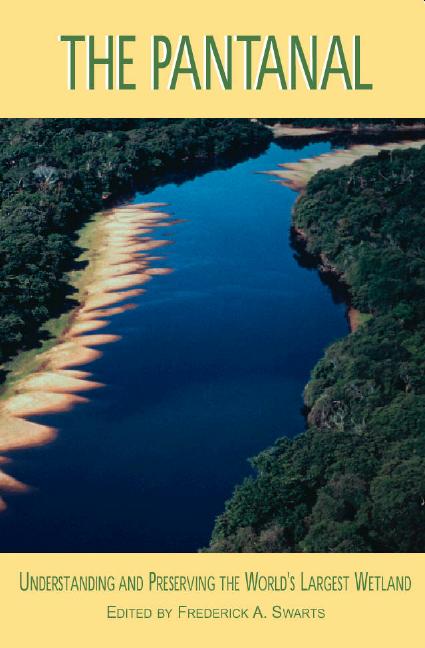--Wetlands, Journal of the Society of Wetland Scientists
A Wildlife Sanctuary of Spectacular Beauty
The Pantanal of South America is one of the most immense,
pristine and biologically rich environments on the planet. Often referred
to as the world’s largest freshwater wetland system, it extends over 60,000
square miles of central-western Brazil, eastern Bolivia and eastern Paraguay.
With its extraordinarily concentrated and diverse flora and fauna and
a landscape spanning a variety of ecological sub-regions, the Pantanal
remains one of the world’s great natural wonders.
This area is an unparalleled wildlife sanctuary of spectacular beauty, an ecological paradise containing hundreds of species of birds, thousands of varieties of butterflies, myriads of brightly colored flowers, and shoals of fish. Capuchin and Howler monkeys, capybaras, toucans, anacondas, caimans, and tapirs help create an aquatic and sylvan theater of sights and sounds. The endangered jaguar, and increasingly rare Hyacinthine macaws and giant river otters, all make their home in the Pantanal. And yet, despite the region’s beauty and remarkable environmental and economic value, the Pantanal remains relatively unknown and faces an uncertain future.
 |
 |
 |
  |
This collection of papers and presentations on the Pantanal represents the best and most comprehensive material on this vast, endangered region. Many of the world’s foremost authorities from Brazil, Bolivia, Paraguay and other nations, and from key international and inter-governmental organizations share their knowledge of the Pantanal, and their insights on the socioeconomic challenges confronting this ecological treasure.
Table of Contents
Foreword
Preface
Introduction
1. The Pantanal in the 21st Century: For the Planets Largest
Wetland, an Uncertain Future
Dr. Frederick A. Swarts
Part I: Overview of the Pantanal
2. The Pantanal and the Paraguay River Basin: From the
Technical Focus to the Political Option
Dr. Juan Maria Carron
3. The Brazilian Pantanal: An Overview
Ana Lucia Lima Barros Dolabella
4. Wetlands in Bolivia: Pantanal Preservation and Sustainable Development
Professor Carlos Aguirre
5. The Pantanal of Paraguay
Dr. Juan Maria Carron
6. Geology of the Pantanal Region
Dr. Antonio Segovia
Part II: Preservation of the Pantanal
7. The Pantanal Today, Prospects for Tomorrow
Adalberto Eberhard
8. Protected Areas in the Bolivian Pantanal
Maria Esther Montano
9. Pantanal National Park Preservation and the Integrated Efforts
of the Brazilian Government Towards Areas under Federal, State and Private
Protection
Dr. Jose A. Ferraz de Lima
Part III: Economic Development
10. Ecotourism in the Pantanal and its Role as a Viable Economic Incentive
for Conservation
Douglas Trent
11. Ecotourism as a Tool for Sustainable Development in the Pantanal
Reinaldo Lourival
12. Ecotourism in Mato Grosso do Sul: The New Business Opportunity
Deputy Paulo Jose Arujo Correa
13. Cattle Grazing and Sustainable Plant Diversity in the Pantanal:
What do We Know? What do We Need to Know?
Dr. Ronald H. Fortney
14. The Paraguay-Parana Hidrovia: Large-scale Channelization or a “Tyranny of Small Decisions”?
Dr. Johan F. Gottgens
15. Research for Sustainable Development of the Brazilian Pantanal
Dr. Mario Dantas
Part IV: International Organizations and the Pantanal
16. Implementation of Integrated Management Practices for the
Pantanal and the Upper Paraguay River Basin
Dr. Nelson da Franca Ribeiro dos Anjos
17. Ramsar Convention and the Pantanal
Dr. Bill Phillips
18. The World Bank and the Pantanal
Dr. John Redwood
19. UNEP and the Pantanal
Ricardo Sanchez Sosa
Part V: Lessons From Other Systems
20. Lessons from the Everglades
Ernest Barnett
21. Wetland Ecotones and the Role of the Private Sector in Conservation and Management of the Pantanal
Dr. Thomas L. Crisman
22. Economic Development and Environmental Conservation in Korea: The Relevance of Korean Wetland Experiences to the Pantanal
Dr. Soo Young Park & Dr. Chan Won Lee
Part VI: Dynamic Between Economic Development and Environmental Preservation
23. The Profound Shift Toward an Environmentally Sustainable Economy
Janet Abramovitz
24. Sustainable Development: An Integrated Approach
Jorge Rucks
25. A Measure of Optimism
Dr. Noel Brown
Part VII: World Conference on Preservation and Sustainable Development in the Pantanal
26. The International Environment: Challenges and Opportunities
Senator Richard G. Lugar
27. Pantanal: A Global Heritage
Dr. Marcelo Alonso
28. The Pantanal and the Pantaneiros: Heartfelt Challenges and New Opportunities
Dr. Chung Hwan Kwak
29. Fundamental Considerations for the Future of the Pantanal
Dr. Wally N’Dow
Contributors
Sponsoring Organizations
Abbreviations and Acronyms
DR. FREDERICK A. SWARTS serves as Secretary-General of the World Conference on Preservation and Sustainable Development in the Pantanal (WCPSDP), an international project to elucidate more clearly the nature of the Pantanal, by identifying threats to this system, advancing initiatives towards its future, and fostering worldwide supporting mechanisms. Dr. Swarts is also Senior Research Scientist for Aquatic Ecology with the Waterland Research Institute; in this capacity he is responsible for the institute’s water resources projects in the Pantanal area of Brazil. Dr. Swarts has published widely in the fields of aquatic ecology, education, and environmental biology. He lives in Gouldsboro, Pennsylvania and Brazil.






